First Things magazine's podcast features an interview of National Civic Art Society president Justin Shubow by senior editor Mark Bauerlein in which they discuss legislation pending in the U.S. House and Senate that would dramatically re-orient federal architecture from modernism to classical and traditional design. The bills would require that public input be given substantial weight when the government makes design decisions.
You can listen to the podcast HERE.
Relatedly, Politico interviewed Shubow about the aforementioned legislation. To quote the article:
The growth of government in the decades after World War II happened to take place during one of the most maligned periods in public architecture. Like college campuses, government properties have been among the modernist era’s most conspicuous offenders, perhaps because the people commissioning the buildings were not the ones who would have to live or work in them. When it’s their own private home or business, people tend to be much less deferential to the artistes drawing up the blueprints.
In Shubow’s telling, that deference is the problem — baked right into the 1962 [Guiding Principles for Federal Architecture] his rivals want to enshrine in law. “Design must flow from the architectural profession to the Government,” it declares, “and not vice versa.” Rather than a gesture of support for creativity, he says, the language essentially orders public servants to abandon their duty of keeping an eye on the contractors. (He notes that the AIA, which has blasted the GOP bill in the name of free expression, isn’t quite a dispassionate academic group: It’s a trade association for architects, i.e. those very same contractors.) ...
Shubow takes satisfaction in a June report from the Government Accountability Office that advises the GSA to formally require and incorporate community input on building designs — a byproduct, he says, of the attention given to Trump’s classical-architecture orders.
It’s a recommendation that’s going to be hard for anyone in politics to criticize, no matter what their opinions on au courant architecture. For elected officials, it may feel un-American to legislate a default national style — but it would seem downright suicidal to openly tell the general public that their views don’t count.





















